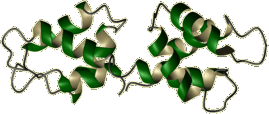
|
Ubiquitin (Ub) is a 76 residue,
highly conserved protein found in all eukaryotic organisms. Ubiquitin itself does not perform
any catalytic, transportative, or structural function. Rather, it is a signalling mechanism
where some other regulatory mechanism will use it to label a target protein for a particular fate.
It is best known for its role in ATP dependent protein degradation.
|

|
Calmodulin (CaM) is one of the best
known examples calcium binding regulatory proteins in intracellular signalling pathways. Like
Ubiquitin, it is highly conserved and abundant in all eukaryotic cells. As a signalling protein,
Calmodulin's function is to bind calcium ions and then bind a target protein, affecting its
activity. It affects processes ranging from neurotransmitter release to membrane protein
organization.
|

|
Lysozyme (Lys) is an enzyme that plays
an important role in the prevention of bacterial infections. It does this by attacking a specific
component of certain bacterial cell walls, peptidoglycan. It was discovered by Alexander Fleming
in 1921 when he demonstrated that his own nasal mucus had the ability to inhibit the growth of a
certain strain of bacteria in culture. In 1966, David Chilton Phillips, using x-ray
crystallography, determined lysozyme's structure, the first ever solved for an enzyme.
It has been an important experimental model ever since.
|

|
Dihydrofolate Reductase (DHFR) is a very important
enzyme because it produces cofactors that are necessary for DNA synthesis. Specifically, DHFR
catalyzes the reduction of folate and 7,8-dihydrofolate (DHF) to 5,6,7,8-tetrahydrofolate (THF).
THF is an essential cofactor involved in the the transfer of methyl, methylene, and formyl groups
from one molecule to another during the production of nucleotides and several amino acids.
An important example of this is the utilization of carbon units from a THF cofactor by
thymidylate synthase to make thymidine nucleotides.
|

|
Isovelleral is a secondary metabolite responsible for "hot",
spicy flavor of certain plants and fingi. It is one of the compounds believed to form a multifaceted
chemical defense system that protects organisms from parasites and predators, covalently binding
primary amine residues in proteins. It is being investigated as a source for novel analgesics as
well as various anti-tumor drugs.
|

|
Cardiolipin: one of the bacterial lipids actively
studied by Nutritional and Health Sciences as well as by New Materials Science and Biotechnology.
Their importance ranges from their role in fatty acid and cholesterol metabolism to technological
applications in advanced drug delivery systems and hybrid materials.
|

|
Skatole's name is derived from the Greek root skato- meaning "dung".
It is one of metabolites responsible for the rotten smell of "Corpse Flower" Titan Arum, but it is also found
in orange blossoms and jasmine. Skatole is one of many compounds that is attractive to males of various species
of bee and beetles.
|

|
Beta-carotene is a red-orange pigment that gives color to carots.
It is a well-known anti-oxidant, a precursor to vitamin A, and a widely used food coloring.
|

|
Naringenin is a flavanone found in grapefruits and oranges.
It is one of the favonoids being investigated for their efects on human health as antioxidants and
promoters of healthy metabolism and immune system.
|

|
Protoporphyrin IX: one of natural metabolites used in
photobiovoltaic solar cells.
|

|
Berberine: an alcaloid widely used in traditional
medicine.
|

|
Plant hormones: salicylic, jasmonic, and abscisic acids.
|

|
Medicine from the sea: aspergillic acid.
|

|
Artemisinin and Artemisia absinthium.
|

|
Colchicine and other natural compounds in treatment of SARS-CoV-2.
|

|
Compounds from NIH National Cancer Institute's
Development Therapeutic Program Repository
of Natural Products.
|
















